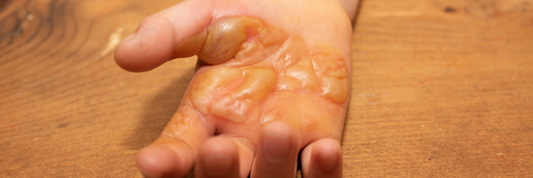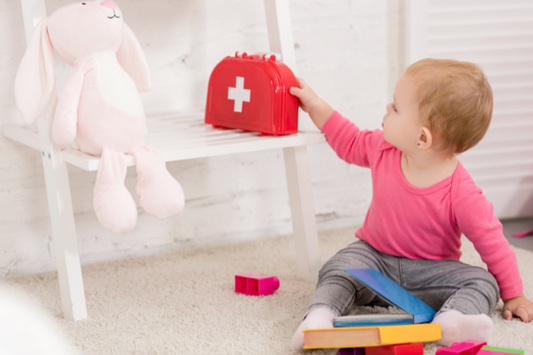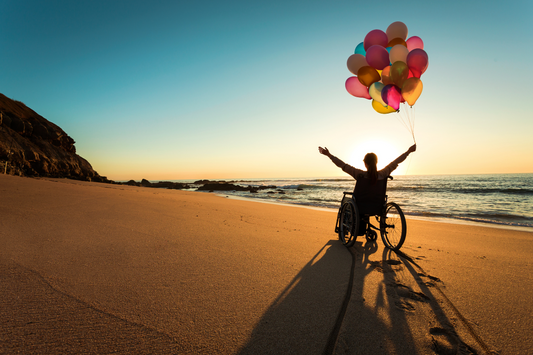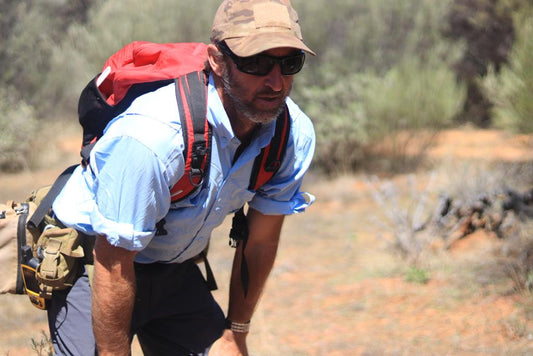Australia's remote and diverse landscape invites people of all ages to explore. It offers some of the most beautiful coastlines, rainforests, deserts, and alpine mountains in the world. A hiking first aid kit is crucial when heading into the vast, isolated bushlands of our beautiful country and needs careful planning. It is essential that you prepare for the area you want to explore. A reliable hiking first aid kit will always make your adventure is as enjoyabe as possible. It is critical when emergency care might take time to arrive
This blog is for tourists and Aussie hikers. It offers a simple guide to building your first aid kit. Plus I will share some well known survival laws observed by adventurers worldwide, and a downloadable hike planning checklist!

The Rule of 3s: Your Outback Survival Mantra
Do you know about the rule of 3s?
There are plenty of variables such as age, health and fitness. The rule of 3’s need to be at the forefront of your planning on any hike.
3 minutes without air: This is pretty straight forward. Lack of oxygen to the brain will result in loss of life in around 3 minutes
3 hours without shelter: In severe conditions such as extreme heat and subzero environments.
You can usually survive for 3 days without water. This rule can change if you are hurt, can't find shelter, or have health issues.
3 weeks without food: While food is important, it becomes a secondary concern in short-term survival situations. Remember, you can’t make heat, if you don’t eat!
These rules serve as a powerful reminder to plan your hike in the event it becomes a survival scenario. Your first aid kit should reflect this, focusing on essential items that address immediate threats to life.
Packing a hiking first aid kit fit for Australian conditions
Now, let's personalise your first aid kit to your hike!
How long will you be hiking and where are you going? A simple tourist trail in a national park is very different from a multi-day trek in remote bushland. Longer trips and challenging environments demand a more comprehensive approach to first aid.
How many people?: Are you a solo adventurer or leading a group of mates? Is your group fit, or inexperienced? Factor in the needs of everyone in your tour. Include pre-existing medical conditions such as anaphylaxis, and required medications. Also consider the likely injuries common to hiking such as sprains and blisters
What type of activities: Bushwalking, rock climbing, canyoning – each activity has its own set of potential injuries. Build your kit to suit.
Climate and Season: Consider the unique challenges of each Aussie season. Pack extra water and sun protection in summer, and be prepared for hypothermia in winter.
The Essentials: Basic First Aid Supplies
Back in 2015, I actually completed the Kokoda Track. While I didn’t experience any major trauma, I hit my first aid kit on a daily basis. I can assure you, my experience would have been much less enjoyable had I not packed a well rounded first aid bag.
For hiking in particular, I cannot express the importance of foot care first! My strongest recommendation is high quality socks with individual toes, foot balm and the best quality blister specific bandaids.
And try them out BEFORE you go! 100km in mountainous terrain rely on your foot health. Sore feet cause accidents that otherwise would not happen, such as trips, falls and infection.
- Wound Care:
Assorted Plastic & Fabric Bandaids: Stock up on various sizes and shapes to address cuts, scrapes, and blisters.
Sterile Gauze Pads: Essential for cleaning wounds.
Saline: Essential to wet gauze to clean wounds
Antiseptic Wipes: Cleanse wounds effectively to prevent infection.
Medical Tape: To secure dressings.
Rigid Tape: To support sprain and strains
Kinesiology Tape: Preventative therapy to support old injuries
Blister Treatment: Moleskin, blister pads, and specialized blister bandages are crucial for preventing and treating painful blisters.
- Medications:
Pain Relievers: Pack over-the-counter pain medications like ibuprofen or paracetamol for managing pain and inflammation.
Antihistamines: Essential for treating allergic reactions to insect bites, plants, or other allergens.
Anti-diarrheal Medication: Gastrointestinal bugs can strike unexpectedly and impact your hydration rapidly.
Rehydration Salts: Remember you don’t just sweat water. It's salty! You need to replace both with a good quality electrolyte, such as hydrolite.
- Tools and Other Essentials:
Shears: A small pair of shears are vital for cutting bandages, tape, and clothing in emergencies. You will use them for tonnes of other tasks on your trip!
Snake Bite Kit: For applying pressure immobilisation for envenomation (choose a snake bite kit that can serve multiple purposes).
Tweezers: Remove splinters, ticks, and other foreign objects with precision.
Safety Pins: For securing slings, and again, a tonne of other improvisations and repairs!
Emergency Blanket: Provides warmth and protection in case of unexpected weather changes or injuries. These are crucial for shelter (Rule of 3s). Consider a TOG rated blanket in cold climates
Signalling Tool: Signal for help in emergencies.
Water Purification Tablets: Our Kokoda trip relied heavily on water purification tablets. I strongly recommend trying a few before you go, some are a little less pleasant than others.
Waterproof Matches: In case you need to make a fire, and the environment is safe to do so.
Insect repellent: Personally, I wouldn’t take anything other than Bushmans.
Beyond the Basics: Make your Kit a Survival Kit
While first aid supplies can ensure you remain comfortable, consider these additional items in the event of traumatic injury. It is always better to have it and not need it. The following items support the rule of 3;s in the event of a lifethreatening situation.

Additional IFAK: Contains trauma items, and is worn for immediate access
Tourniquet: to immediately control life threatening bleeds
LIFE Tent: Versatile lightweight form of shelter, signalling and protection from hypothermia
Snake Bite Bandage: Essential for hiking in areas with venomous snakes – and we have plenty in Australia!
Aluminium Splint: A lightweight and versatile splint for immobilising fractures and sprains.
Antibiotic Ointment: Prevent infection in deeper wounds.
Hydrocortisone Cream: Reduce inflammation and itching from insect bites and rashes.
Eye Drops: Soothe irritated eyes caused by dust, wind, or allergies.
Duct Tape: Repair gear, secure splints, and offer additional support for injuries.
Body & Mind: The Mental First Aid Kit
Physical injuries are a common concern, but mental well-being is equally important on the trail. Anxiety, stress, and even feelings of isolation can impact your experience. Consider adding a "mental first aid kit" to your pack:
Journal and Pen: Express your thoughts and emotions, promoting self-reflection and stress relief. Also great to document your experiences on your adventure.
Calming Essential Oils: Lavender or chamomile essential oils can promote relaxation and reduce anxiety.
Positive Affirmations: Carry a list of positive affirmations or inspiring quotes to boost your mood and motivation.
Comfort Object: While I don’t suffer greatly from serious mental health problems, the Kokoda Track was very confronting. I carried some pictures of my kids and a good luck crystal from a close friend. They were a great sense of comfort after a long hard day in a some what scary environment.
Keeping your Kit Ready
Identify & Organise: Use clear containers or ziplock bags to arrange your kit. Label everything clearly for quick access in emergencies.
Waterproof and Lightweight: Choose a durable, waterproof bag to protect your supplies from the elements. Prioritize lightweight items to avoid unnecessary bulk.
Regularly Check and Restock: Inspect your kit before every hike, replacing used or expired items. Ensure medications are within their expiry dates.
Remote First Aid Training: Invest time in learning basic first aid and remote survival skills. Consider taking a remote first aid course to gain confidence in handling emergencies.
These references are excellent Australian resources for more information to help you plan the safest most enjoyable hike.
Australian Hiking: https://australianhiker.com.au/
NSW National Parks and Wildlife Service: https://www.nationalparks.nsw.gov.au/ - Provides valuable information on park safety, trail conditions, and emergency procedures.
Bushwalking NSW: https://www.bushwalkingnsw.org.au/ - Offers resources and advice on bushwalking safety, including first aid and navigation.
Trail Hiking Australia https://www.trailhiking.com.au/
Outdoors NSW: https://www.outdoorsnswact.org/ - Promotes responsible outdoor recreation and provides information on safety, gear, and environmental awareness.
When you take time to build your hiking first aid kit, you are not just packing supplies. You are also packing comfort and peace of mind. Plan to enjoy your adventures knowing you're prepared to handle serious challenges that come your way!


















